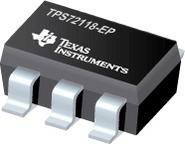● Controlled Baseline
● One Assembly Site
● One Test Site
● One Fabrication Site
● Extended Temperature Performance of 55°C to 125°C
● Enhanced Diminishing Manufacturing Sources (DMS) Support
● Enhanced Product-Change Notification
● Qualification Pedigree(1)
● 150 mA Low-Dropout (LDO)
● Available in 1.8 V Fixed-Output Version
● Low Input Voltage Requirement (Down to 1.8 V)
● Small Output Capacitor, 0.1 µF
● Dropout Voltage Typically 200 mV at 150 mA
● Less Than 3µA Quiescent Current in Shutdown Mode
● Thermal Protection
● Over Current Limitation
● 5-Pin SOT-23 (DBV) Package
● APPLICATIONS
● Portable Communication Devices
● Battery-Powered Equipment
● PCMCIA Cards
● Personal Digital Assistants
● Modems
● Bar Code Scanners
● Backup Power Supplies
● SMPS Post Regulation
● Internet Audio
●(1) Component qualification in accordance with JEDEC and industry standards to ensure reliable operation over an extended temperature range. This includes, but is not limited to, Highly Accelerated Stress Test (HAST) or biased 85/85, temperature cycle, autoclave or unbiased HAST, electromigration, bond intermetallic life, and mold compound life. Such qualification testing should not be viewed as justifying use of this component beyond specified performance and environmental limits.
●## DESCRIPTION/ORDERING INFORMATION
●The TPS72118 family of LDO regulators is available in fixed voltage options that are commonly used to power the latest DSPs and microcontrollers with a fixed output to 1.8 V. These regulators can be used in a wide variety of applications ranging from portable, battery-powered equipment to PC peripherals. The family features operation over a wide range of input voltages (1.8 V to 5.5 V) and low dropout voltage (150 mV at full load). Therefore, compared to many other regulators that require 2.5 V or higher input voltages for operation, these regulators can be operated directly from two AAA batteries. Also, the typical quiescent current (ground pin current) is low, starting at 85 µA during normal operation and 3 µA in shutdown mode. These regulators can be operated very efficiently and, in a battery-powered application, help extend the longevity of the device.
●Similar LDO regulators require 1 µF or larger output capacitors for stability. However, this regulator uses an internal compensation scheme that stabilizes the feedback loop over the full range of input voltages and load currents with output capacitances as low as 0.1 µF. Ceramic capacitors of this size are relatively inexpensive and available in small footprints.
●This family of regulators is particularly suited as a portable power supply solution due to its minimal board space requirement and 1.8 V minimum input voltage. Being able to use two off-the-shelf AAA batteries makes system design easier and also reduces component cost. Moreover, the solution is more efficient than if a regulator with a higher input voltage is used.



